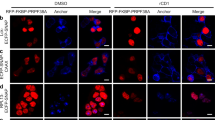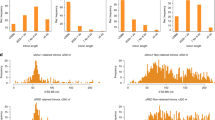Abstract
C2 domains are widespread Ca2+-binding modules. The active zone protein Piccolo (also known as Aczonin) contains an unusual C2A domain that exhibits a low affinity for Ca2+, a Ca2+-induced conformational change and Ca2+-dependent dimerization. We show here that removal of a nine-residue sequence by alternative splicing increases the Ca2+ affinity, abolishes the conformational change and abrogates dimerization of the Piccolo C2A domain. The NMR structure of the Ca2+-free long variant provides a structural basis for these different properties of the two splice forms, showing that the nine-residue sequence forms a β-strand otherwise occupied by a nonspliced sequence. Consequently, Ca2+-binding to the long Piccolo C2A domain requires a marked rearrangement of secondary structure that cannot occur for the short variant. These results reveal a novel mechanism of action of C2 domains and uncover a structural principle that may underlie the alteration of protein function by short alternatively spliced sequences.
This is a preview of subscription content, access via your institution
Access options
Subscribe to this journal
Receive 12 print issues and online access
$189.00 per year
only $15.75 per issue
Buy this article
- Purchase on Springer Link
- Instant access to full article PDF
Prices may be subject to local taxes which are calculated during checkout







Similar content being viewed by others
Accession codes
References
Nalefski, E.A. & Falke, J.J. The C2 domain calcium-binding motif: structural and functional diversity. Protein Sci. 5, 2375–2390 (1996).
Rizo, J. & Südhof, T.C. C2-domains, structure and function of a universal Ca2+-binding domain. J. Biol. Chem. 273, 15879–15882 (1998).
Lander, E.S. et al. Initial sequencing and analysis of the human genome. Nature 409, 860–921 (2001).
Fernandez-Chacon, R. et al. Synaptotagmin I functions as a calcium regulator of release probability. Nature 410, 41–49 (2001).
Südhof, T.C. Synaptotagmins: why so many? J. Biol. Chem. 277, 7629–7632 (2002).
Tucker, W.C. & Chapman, E.R. Role of synaptotagmin in Ca2+-triggered exocytosis. Biochem. J. 366, 1–13 (2002).
Davletov, B.A. & Südhof, T.C. A single C2 domain from synaptotagmin I is sufficient for high affinity Ca2+/phospholipid binding. J. Biol. Chem. 268, 26386–26390 (1993).
Li, C. et al. Ca(2+)-dependent and -independent activities of neural and non-neural synaptotagmins. Nature 375, 594–599 (1995).
Davis, A.F. et al. Kinetics of synaptotagmin responses to Ca2+ and assembly with the core SNARE complex onto membranes. Neuron 24, 363–376 (1999).
Fernandez, I. et al. Three-dimensional structure of the synaptotagmin-1 c(2)b-domain. synaptotagmin-1 as a phospholipid binding machine. Neuron 32, 1057–1069 (2001).
Sutton, R.B., Davletov, B.A., Berghuis, A.M., Südhof, T.C. & Sprang, S.R. Structure of the first C2 domain of synaptotagmin I: a novel Ca2+/phospholipid-binding fold. Cell 80, 929–938 (1995).
Shao, X., Fernandez, I., Südhof, T.C. & Rizo, J. Solution structures of the Ca2+-free and Ca2+-bound C2A domain of synaptotagmin I: does Ca2+ induce a conformational change? Biochemistry 37, 16106–16115 (1998).
Ubach, J., Zhang, X., Shao, X., Südhof, T.C. & Rizo, J. Ca2+ binding to synaptotagmin: how many Ca2+ ions bind to the tip of a C2-domain? EMBO J. 17, 3921–3930 (1998).
Zhang, X., Rizo, J. & Südhof, T.C. Mechanism of phospholipid binding by the C2A-domain of synaptotagmin I. Biochemistry 37, 12395–12403 (1998).
Shao, X. et al. Synaptotagmin-syntaxin interaction: the C2 domain as a Ca2+-dependent electrostatic switch. Neuron 18, 133–142 (1997).
Essen, L.O., Perisic, O., Lynch, D.E., Katan, M. & Williams, R.L. A ternary metal binding site in the C2 domain of phosphoinositide-specific phospholipase C-δ1. Biochemistry 36, 2753–2762 (1997).
Lomasney, J.W., Cheng, H.F., Roffler, S.R. & King, K. Activation of phospholipase C δ1 through C2 domain by a Ca(2+)-enzyme-phosphatidylserine ternary complex. J. Biol. Chem. 274, 21995–22001 (1999).
Perisic, O., Fong, S., Lynch, D.E., Bycroft, M. & Williams, R.L. Crystal structure of a calcium-phospholipid binding domain from cytosolic phospholipase A2. J. Biol. Chem. 273, 1596–1604 (1998).
Perisic, O., Paterson, H.F., Mosedale, G., Lara-Gonzalez, S. & Williams, R.L. Mapping the phospholipid-binding surface and translocation determinants of the C2 domain from cytosolic phospholipase A2. J. Biol. Chem. 274, 14979–14987 (1999).
Ubach, J., Garcia, J., Nittler, M.P., Südhof, T.C. & Rizo, J. Structure of the Janus-faced C2B domain of rabphilin. Nat. Cell Biol. 1, 106–112 (1999).
Uellner, R. et al. Perforin is activated by a proteolytic cleavage during biosynthesis which reveals a phospholipid-binding C2 domain. EMBO J. 16, 7287–7296 (1997).
Verdaguer, N., Corbalan-Garcia, S., Ochoa, W.F., Fita, I. & Gomez-Fernandez, J.C. Ca(2+) bridges the C2 membrane-binding domain of protein kinase Cα directly to phosphatidylserine. EMBO J. 18, 6329–6338 (1999).
Gerber, S.H., Garcia, J., Rizo, J. & Südhof, T.C. An unusual C(2)-domain in the active-zone protein Piccolo: implications for Ca(2+) regulation of neurotransmitter release. EMBO J. 20, 1605–1619 (2001).
Wang, X. et al. Aczonin, a 550-kD putative scaffolding protein of presynaptic active zones, shares homology regions with Rim and Bassoon and binds profilin. J. Cell Biol. 147, 151–162 (1999).
Fenster, S.D. et al. Piccolo, a presynaptic zinc finger protein structurally related to bassoon. Neuron 25, 203–214 (2000).
Garner, C.C., Kindler, S. & Gundelfinger, E.D. Molecular determinants of presynaptic active zones. Curr. Opin. Neurobiol. 10, 321–327 (2000).
Shipston, M.J. Alternative splicing of potassium channels: a dynamic switch of cellular excitability. Trends Cell Biol. 11, 353–358 (2001).
Caceres, J.F. & Kornblihtt, A.R. Alternative splicing: multiple control mechanisms and involvement in human disease. Trends Genet. 18, 186–193 (2002).
Shao, X., Davletov, B.A., Sutton, R.B., Südhof, T.C. & Rizo, J. Bipartite Ca2+-binding motif in C2 domains of synaptotagmin and protein kinase C. Science 273, 248–251 (1996).
Sutton, R.B. & Sprang, S.R. Structure of the protein kinase Cβ phospholipid-binding C2 domain complexed with Ca2+. Structure. 6, 1395–1405 (1998).
Zucker, R.S. Short-term synaptic plasticity. Annu. Rev. Neurosci. 12, 13–31 (1989).
Dobrunz, L.E. & Stevens, C.F. Response of hippocampal synapses to natural stimulation patterns. Neuron 22, 157–166 (1999).
Dittman, J.S., Kreitzer, A.C. & Regehr, W.G. Interplay between facilitation, depression, and residual calcium at three presynaptic terminals. J. Neurosci. 20, 1374–1385 (2000).
Guan, K.L. & Dixon, J.E. Eukaryotic proteins expressed in Escherichia coli: an improved thrombin cleavage and purification procedure of fusion proteins with glutathione S-transferase. Anal. Biochem. 192, 262–267 (1991).
Zhang, O., Kay, L.E., Olivier, J.P. & Forman-Kay, J.D. Backbone 1H and 15N resonance assignments of the N-terminal SH3 domain of drk in folded and unfolded states using enhanced-sensitivity pulsed field gradient NMR techniques. J. Biomol. NMR 4, 845–858 (1994).
Kay, L.E., Xu, G.Y. & Yamazaki, T. Enhanced-sensitivity triple-resonance spectroscopy with minimal H2O saturation. J. Magn. Reson. A 109, 129–133 (1994).
Muhandiram, D.R. & Kay, L.E. Gradient-enhanced triple-resonance three-dimensional NMR experiments with improved sensitivity. J. Magn. Reson. B 103, 203–216 (1994).
Kay, L.E., Xu, G.Y., Singer, A.U., Muhandiram, D.R. & Forman-Kay, J.D. A gradient-enhanced HCCH-TOCSY experiment for recording side-chain 1H and 13C correlations in H2O samples of proteins. J. Magn. Reson. B 101, 333–337 (1993).
Delaglio, F. et al. NMRPipe: a multidimensional spectral processing system based on UNIX pipes. J. Biomol. NMR 6, 277–293 (1995).
Johnson, B.A. & Blevins, R.A. NMRView: a computer program for the visualization and analysis of NMR data. J. Biomol. NMR 4, 603–614 (1994).
Cornilescu, G., Delaglio, F. & Bax, A. Protein backbone angle restraints from searching a database for chemical shift and sequence homology. J. Biomol. NMR 13, 289–302 (1999).
Brunger, A.T. et al. Crystallography & NMR System: a new software suite for macromolecular structure determination. Acta Crystallogr. D 54, 905–921 (1998).
Laskowski, R.A., Macarthur, M.W., Moss, D.S. & Thornton, J.M. PROCHECK: a program to check the stereochemical quality of protein structures. J. Appl. Crystallogr. 26, 283–291 (1993).
Kraulis, P.J. MOLSCRIPT: a program to produce both detailed and schematic plots of protein structures. J. Appl. Crystallogr. 24, 946–950 (1991).
Holm, L. & Sander, C. Protein structure comparison by alignment of distance matrices. J. Mol. Biol. 233, 123–138 (1993).
Acknowledgements
We thank I. Leznicki, A. Roth, and E. Borowicz for technical assistance, I. Fernandez for initial studies on the Ca2+ affinity of the Piccolo C2A domain and D. Myers for assistance with analytical ultracentrifugation. This study was supported by grants from the Welch Foundation (I-1304, J.R.), the Perot Family Foundation (T.C.S.), US National Institutes of Health grant NS40944 (J.R. and T.C.S.) and a fellowship from the Deutsche Forschungsgemeinschaft (S.H.G).
Author information
Authors and Affiliations
Corresponding authors
Ethics declarations
Competing interests
The authors declare no competing financial interests.
Supplementary information
Rights and permissions
About this article
Cite this article
Garcia, J., Gerber, S., Sugita, S. et al. A conformational switch in the Piccolo C2A domain regulated by alternative splicing. Nat Struct Mol Biol 11, 45–53 (2004). https://doi.org/10.1038/nsmb707
Received:
Accepted:
Published:
Issue Date:
DOI: https://doi.org/10.1038/nsmb707
This article is cited by
-
Metal Binding Antimicrobial Peptides in Nanoparticle Bio-functionalization: New Heights in Drug Delivery and Therapy
Probiotics and Antimicrobial Proteins (2020)
-
Roles of alternative splicing in modulating transcriptional regulation
BMC Systems Biology (2017)
-
Piccolo mediates EGFR signaling and acts as a prognostic biomarker in esophageal squamous cell carcinoma
Oncogene (2017)
-
Piccolo paralogs and orthologs display conserved patterns of alternative splicing within the C2A and C2B domains
Genes & Genomics (2016)
-
Understanding the molecular machinery of genetics through 3D structures
Nature Reviews Genetics (2008)



